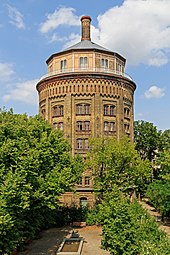Prenzlauer Berg water tower
The Prenzlauer Berg water tower is the oldest Berlin water tower , completed in 1877 and in operation until 1952. It stands between Knaackstrasse and Belforter Strasse in the Kollwitzkiez of the Prenzlauer Berg district ( Pankow district ) of Berlin and, based on the principle of communicating tubes, served to supply the rapidly growing former workers' district. Below the water tank were the apartments of the tower's machine workers; these apartments in the landmark of Prenzlauer Berg are still inhabited and very popular today. As a symbol, it was part of the two district coats of arms from 1920 to 1987 and 1987 to 1992.
→ Main article Wasserturmplatz
After the " seizure of power " by the National Socialists , the SA machine house I, which was part of the water tower, was used by the SA in spring 1933 as a "wild concentration camp ", in which communists, socialists, Jews and other people who were unwelcome to the new rulers were interned and murdered without a court judgment. A memorial wall on the site of the water tower has been commemorating these crimes since 1981. From June 1933, the KL was converted into the "SA-Heim Wasserturm". The approximately 1000 m² machine house I, built in 1877, served the SA members as a dining room and lounge, while machine house II served as a dormitory. In the autumn of 1934, the SA home was closed and the redesign of the site into a public green area began. In the course of this measure, the machine house I was blown up in June 1935. The green space was inaugurated on May 1, 1937 . Today there is a playground at the location of machine house I.
See also
literature
- Jens U. Schmidt: Water towers in Berlin. Capital of the water towers. Regia-Verlag, Cottbus 2010, ISBN 978-3-86929-032-4 .
Web links
- Entry in the Berlin State Monument List
- Bernd Wähner: From waterworks to local recreation. In: Berlin Week. March 25, 2018, accessed June 4, 2020 (German).
Coordinates: 52 ° 32 '3.08 " N , 13 ° 25' 6.82" E


